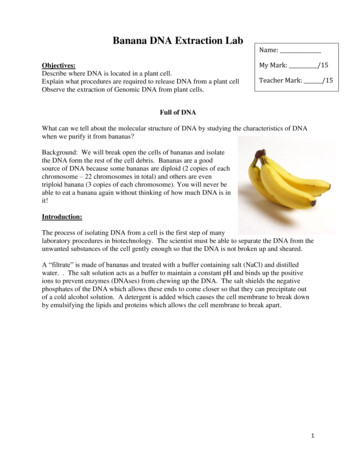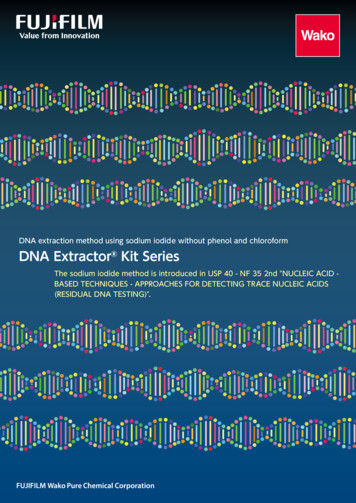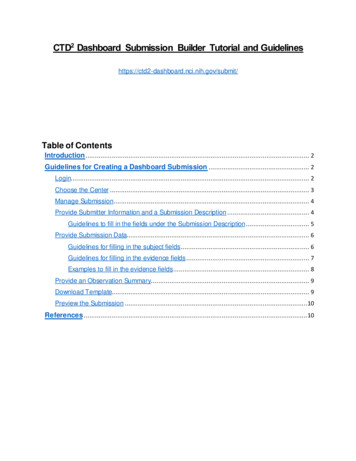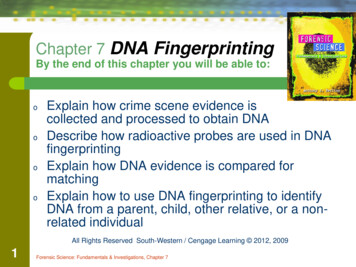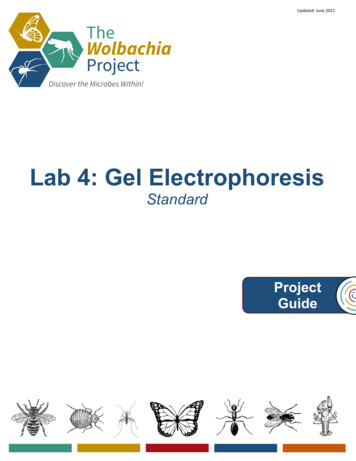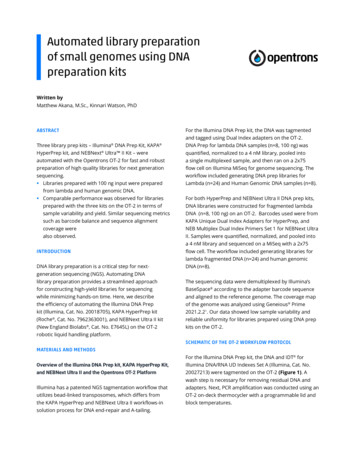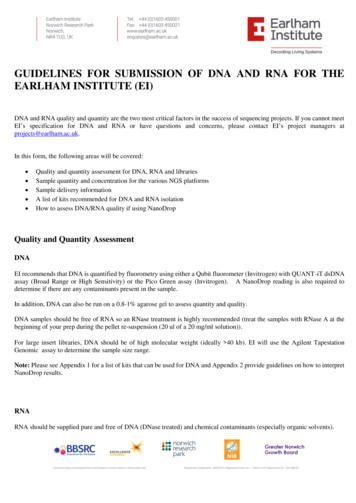
Transcription
GUIDELINES FOR SUBMISSION OF DNA AND RNA FOR THEEARLHAM INSTITUTE (EI)DNA and RNA quality and quantity are the two most critical factors in the success of sequencing projects. If you cannot meetEI’s specification for DNA and RNA or have questions and concerns, please contact EI’s project managers atprojects@earlham.ac.uk.In this form, the following areas will be covered: Quality and quantity assessment for DNA, RNA and librariesSample quantity and concentration for the various NGS platformsSample delivery informationA list of kits recommended for DNA and RNA isolationHow to assess DNA/RNA quality if using NanoDropQuality and Quantity AssessmentDNAEI recommends that DNA is quantified by fluorometry using either a Qubit fluorometer (Invitrogen) with QUANT-iT dsDNAassay (Broad Range or High Sensitivity) or the Pico Green assay (Invitrogen). A NanoDrop reading is also required todetermine if there are any contaminants present in the sample.In addition, DNA can also be run on a 0.8-1% agarose gel to assess quantity and quality.DNA samples should be free of RNA so an RNase treatment is highly recommended (treat the samples with RNase A at thebeginning of your prep during the pellet re-suspension (20 ul of a 20 mg/ml solution)).For large insert libraries, DNA should be of high molecular weight (ideally 40 kb). EI will use the Agilent TapestationGenomic assay to determine the sample size range.Note: Please see Appendix 1 for a list of kits that can be used for DNA and Appendix 2 provide guidelines on how to interpretNanoDrop results.RNARNA should be supplied pure and free of DNA (DNase treated) and chemical contaminants (especially organic solvents).
RNA quality can be assessed by either running it on a 0.8-1% agarose gel or preferably on a Bioanalyzer RNA chip (Seeexamples in the figure below). The RIN number (RNA integrity number) should be of 8 or higher for mammalian samples,and 7 or above for non-mammalian and plant samples. Although we advise discussing any more unusual sample types (shownon the Bioanalyzer result page).RNA quantity should be estimated using fluorometry, preferably using Qubit fluorometer with QUANT-iT RNA assay(Invitrogen). If this method is not available, please note that spectrophotometry methods can provide inaccurate measurementsdue to contaminating chemicals.Note: Please see Appendix 1 for a list of kits that can be used for RNA isolation.Figure: The left figure shows the profile of a good quality RNA sample from bacteria and the right figure showsgood quality RNA from a plant.
Sample Quantity and ConcentrationThe quantity of DNA or RNA required for sequence library preparation is dependent on the application and the sequencingplatform. Please note that the quantities listed in the table below are the recommended values as of June 2016. These maychange with new protocols and advancements. If due to the nature of your sample or custom library preparation it is difficult toprovide EI with the requested quantity/quality in this table, please get in touch with projects@earlham.ac.uk before starting yourextractions or library construction to discuss options.Table1: This table shows the quantity of DNA and RNA required per application and per platform.ILLUMINATruSeq RNASmall RNAGenomic DNAChIP seqNexteraNextera XTPre-made librariesMate PairPACBIOLarge Insert Library (10-20kb)Amplicon DNAMin 3-5 µg of total RNA (min 50 ng/µl in 60 µl) or 50-100 ng of ribodepleted mRNA in 15 µl.RIN values should be of 8 or above for mammalian samples, and 7 orabove for non-mammalian and plant samples.Please contact projects@earlham.ac.uk for further information.Min 2-5 µg of gDNA (min 35 ng/µl in 60 µl).Absorbance ratios of 260/280 1.6 – 2.0 nm, 260/230 1.8 – 2.4 nm.Min 10 ng of ChIP DNA.Min 50 ng of gDNA (min 2.5 ng/µl in 20 µl).Min 1 ng of gDNA (min 0.2 ng/µl in 5 µl).Min 10 nM in min 25 µl per pool of libraries.Any QC data such as Bioanalyzer traces or qPCR to be supplied ifpossible.Min of 20 µg of DNA of greater than 40kb in size.Min 20 μg of gDNA (min 20 ng/µl) at a minimum molecular weightof 40kb.Absorbance ratios of 260/280 1.8 – 2.0 nm, 260/230 2 nm.Pulse field (or equivalent) images to be supplied if possible.Please contact projects@earlham.ac.uk to discuss further.Min 500 ng of amplicons (13 ng/ µl) of 2-6kb in size.Other applications are currently being implemented and the table will be amended on an ad hoc basis. For enquiries aboutnew applications please discuss your enquiries with EI’s project managers.
Sample delivery informationIt is important that samples are sent using the following recommendations in order to avoid your samples becoming degradedor mislaid.Delivery address:Please send your samples to:Sample ReceptionGenomics Pipelines GroupEarlham InstituteNorwich Research ParkNorwichNR4 7UGUK 44 1603 452900How to send:DNA can be sent in liquid form in low TE (10mM TRIS and 0.1mM EDTA, pH8), or deionised water and sent either on dryice or packaged with ice or cool blocks. Please indicate on the delivery form what your sample has been re-suspended in.Please do not send the sample lyophilised.If HMW DNA is being sent to EI and this is re-suspended in 1x TE buffer then it should remain stable if sent on ice blocks ataround 4 C. In our experience if HMW gDNA is freeze thawed too many times then this can contribute towardsfragmentation which is likely to lead to issues when attempting library construction/sequencing. EI recommends that HMWDNA is not sent on dry ice.RNA should be sent on dry ice, ensuring there is enough dry ice to keep the samples frozen until delivery. Within the samplepackage the individual sample tubes should be contained within a plastic bag that will not degrade when subjected to dry icetemperatures/conditions (i.e. -80 C).EI has had successful deliveries from courier companies such as DHL and FedEx but others may be used. Please note, theRoyal Mail prohibits dry-ice packages and must not be used for shipping samples.Ensure that your samples will arrive on a week day (before 3pm) and not at the weekend.Sample labelling:A sample information form will be sent to you when your project has been accepted. This form needs to be filled in andreturned to EI project management.Following the above, a set of barcode stickers will also be sent to you. These need to be placed on your sample tubes prior tobeing sent. The stickers are suitable for pre-frozen tubes. Samples without barcodes will not be processed.In the case of 8 or more samples being sent, a barcoded plate will be sent out to you. Your samples need to be placed in thewells corresponding to those indicated on your sample information form.
Appendix 1: List of kits that can be used for DNA and RNA isolationDNA DNA Isolation Kits, E.Z.N.A. and E-Z 96 - VWRDNA Isolation Kits allow for the isolation of genomic DNA from a variety of sample types, including blood, soil, stool,bacteria, yeast, insect, cultured cells, mouse tail, and fungal. Most kits are available in mini, midi, maxi, and 96-well formats.Isolated DNA can be used for restriction digest, PCR, southern blotting, and sequencing. Mag-Bind Genomic DNA Kits canbe adapted to most robotic liquid handling 2/e-z-n-a-and-e-z-96-forensic-dna-kits PureLink Genomic DNA – .html# PureLink Viral RNA DNA Mini KitThe PureLink Viral RNA/DNA Mini Kit is a nucleic acid purification system designed for fast and easy isolation of viralRNA or DNA from cell-free samples, such as serum, plasma, and cerebrospinal 2280050 ChargeSwitch Nucleic Acid Purification Technology - InvitrogenChargeSwitch nucleic acid purification technology is the simplest, cleanest, and most effective means of purifying bothDNA and RNA and can be configured in a range of product formats including simple manual purification methods as well ashigh throughput automated home/brands/Product-Brand/ChargeSwitch.html QIAGEN - Animal, Plant, Microorganism, and Other er/dna-preparation/Plant Nuclear DNA preparationPlease contact projects@earlham.ac.uk for a copy of the protocol EI recommends for the isolation of plant nuclear DNA.RNA RNA Isolation Kits, E.Z.N.A. and E-Z 96 - VWR
Kits for the isolation of total RNA or mRNA using manual or automated purification systems. Isolated RNA can be used forNorthern blotting, RT-PCR, nuclease protection assays, in-vitro translation, and microarray analysis. Miniprep kits that useHiBind spin columns use V-spin columns which feature an attached cap and a standard luer tip at the bottom for easy, leakfree connection to a vacuum manifold or luer hub needle. Midi and maxi columns feature a standard vacuum luer for fasterprocessing. These columns can be used for both centrifugation and vacuum rticle number M6731-01 PureLink RNA Mini Kit - InvitrogenThe PureLink RNA Mini Kit provides rapid purification of total RNA from a wide range of cell and tissue types, includinganimal, plant, and yeast cells, bacteria, and 12183018A PureLink miRNA Isolation Kit - InvitrogenThe PureLink miRNA Isolation Kit is uniquely designed to purify cellular small ( 200 nt) RNA molecules, including tRNA,5S rRNA, and 5.8S rRNA, and regulatory RNA molecules such as microRNA (miRNA) and short interfering RNA t/K157001 QIAGEN - Total RNA -RNA/ Cambio – PowerPlant RNA Isolation kitFor fast and easy isolation of inhibitor-free total RNA from even the toughest plant and seed samples, including those high inpolyphenols and ducts/powerplant-rna-isolation-kit/Appendix 2: Assessing DNA/RNA quality using the NanoDropAs absorbance measurements will measure any molecules absorbing at a specific wavelength, nucleic acidsamples will require purification prior to measurement to ensure accurate results. Nucleotides, RNA, ssDNA, anddsDNA all will absorb at 260 nm and contribute to the total absorbance.260/280The ratio of absorbance at 260 nm and 280 nm is used to assess the purity of DNA and RNA. A ratio of 1.8 isgenerally accepted as “pure” for DNA; a ratio of 2.0 is generally accepted as “pure” for RNA. If the ratio isappreciably lower in either case, it may indicate the presence of protein, phenol or other contaminants that absorbstrongly at or near 280 nm.
260/230This ratio is used as a secondary measure of nucleic acid purity. The 260/230 values for “pure” nucleic acid areoften higher than the respective 260/280 values. Expected 260/230 values are commonly in the range of 2.0-2.2. Ifthe ratio is appreciably lower than expected, it may indicate the presence of contaminants which absorb at 230 nm.Change in sample aciditySmall changes in the pH of the solution will cause the 260/280 to vary. Acidic solutions will under-represent the260/280 ratio by 0.2-0.3, while a basic solution will over-represent the ratio by 0.2-0.3.EXAMPLES OF NANODROP PROFILESA typical trace file of nucleic acidEDTA, carbohydrates and phenol all have absorbance near 230 nm
The TRIzol reagent is a phenolic solution which absorbs in the UV both at 230 nm and 270 nmGuanidine HCL used for DNA isolations will absorb at 230 nm
Guanidine isothiocyanate, used for RNA isolations will absorb at 260 nm
If due to the nature of your sample or custom library preparation it is difficult to . TruSeq RNA Min 3-5 µg of total RNA (min 50 ng/µl in 60 µl) or 50-100 ng of ribo-depleted mRNA in 15 µl. RIN values should be of 8 or above for mammalian samples, and 7 or above for non-mammalian and plant samples. Small RNA Please contact projects@earlham.ac.uk for further information. Genomic DNA Min .
